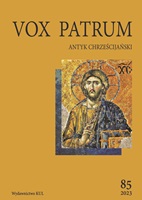Persuasive Function of Sound Figures in Augustine’s Homilies on the Psalms of Ascents and Their Translation into Modern Languages
Persuasive Function of Sound Figures in Augustine’s Homilies on the Psalms of Ascents and Their Translation into Modern Languages
Author(s): Marcela Andoková, Róbert HorkaSubject(s): Cultural history, Social history, Philosophy of Religion, Translation Studies, Sociology of Religion, History of Religion
Published by: Katolicki Uniwersytet Lubelski Jana Pawła II - Wydział Teologii
Keywords: Augustine of Hippo; preaching activity; Enarrationes in Psalmos; sound figures; delectation; persuasive function;
Summary/Abstract: Augustine’s sermons and exegetical homilies have been recently studied by modern scholars not only from the point of view of their contents but also their rhetorical form. This is true especially in those cases where we deal with authentic speeches reflecting the language culture of his audience. One of the most characteristic features of Augustine’s homiletic style is antithetic parallelism which occurs frequently in his homilies on Psalms and results from the author’s own way of thinking. Here we do not deal that much with the biblical parallelism of thought, present in the Hebrew poetry, particularly in Psalms, prophetic speeches, etc., but rather with that which was introduced in Greek by Gorgias, i.e., parallelism of words and sentence structure (parallelismus membrorum). Antithetic parallelism is often accompanied by rhyme (Gr. homoioteleuton) or by assonance. This phenomenon might be observed already in Indo-European poetics but in the rhetorical context of Augustine’s anti-Donatist preaching it serves quite different purposes. By using these and other sound figures (like alliteration, repetition, anaphora, epiphora, etc.) the bishop of Hippo wants not only to please his audience but also to instruct them and, first and foremost, persuade them to return to the Catholic church. Does he use these figures spontaneously imitating the folk culture of his audience, or is he constantly aware of their persuasive force? These and other related questions have already captured attention of several Augustinian scholars of the last decades, so in the present paper we would like to contribute to this foregoing discussion focusing mostly on the persuasive aspect of selected sound figures occurring in Augustine’s Enarrationes in Psalmos 119- 133. Moreover, our aim is to show to which extent they were a part of bishop’s thoroughly considered plan of his homilies, and finally we would like to point out the importance of preserving at least some of these figures in modern translations of Augustine’s homilies.
Journal: Vox Patrum
- Issue Year: 2023
- Issue No: 85
- Page Range: 149-166
- Page Count: 18
- Language: English

